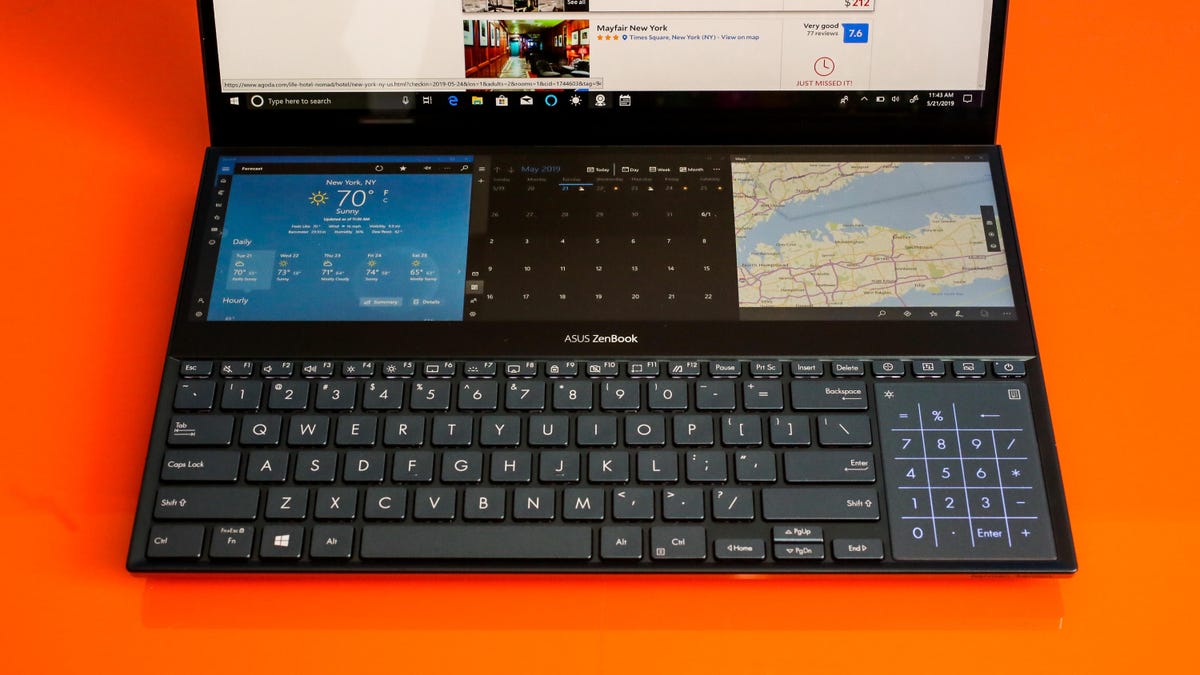
The ZenBook Pro Duo's screen down below
While the ZenBooks have a second touchscreen that's the size and in the location of a typical large touchpad, the Pro Duo's is expanded to the width of the laptop. The virtual number pad to the right of the keyboard now doubles as the touchpad.
A little lift
The Ergolift hinge now angles to 7 degrees, the steepest angle Asus has implemented in one of its laptops. The design improves airflow for cooling and also serves to tilt the second screen to a better viewing angle.
Thicker than usual
Because of the extra screens and the powerful components -- up to a ninth-generation Intel Core i9-9980HK processor and Nvidia GeForce RTX 2060 GPU -- it's not one of the thin ZenBooks.
Virtual number pad
The touchpad on the right side of the keyboard doubles as a number pad.
No palm rests
The compromise for the new layout is no palm rests below the keyboard.
OLED display
The Pro Duo is one of the crop of 15-inch laptops this year to incorporate the new 4K OLED panel.
Screen spanning
You can set it to extend the display of the big screen down to the second one.
The creative use case
In theory, for example, you should be able to put your Creative Cloud Library panel -- as well as other frequently used panels -- below the working area. (Shown is an Asus custom application.)
Sticky windows
You can tile windows within the second screen as well as pin them.
Asus ZenBook Flip 15
Asus is also updating the Flip 15, replacing the standard touchpad with the second generation of its ScreenPad, Asus' small screen version of the ScreenPad Plus that initially debuted in the ZenBook Pro. The ScreenPad 2.0 is a little bigger than before, and much wider than the original touchpad in the Flip 15.
ScreenPad 2.0
The updated version of the ScreenPad is more streamlined to use than the original version -- the custom apps are laid in a familar array, like a phone screen, for one, and Asus has made it quicker to toggle between ScreenPad and touchpad modes. Asus says it also consumes a lot less power now.
Flip 15 only
Asus is upgrading almost all the ZenBooks with the ScreenPad 2.0; one exception is the Flip 14, which the company isn't refreshing with this batch.
Ergolift
The Flip 15 retains the Ergolift hinge of the previous model.
Flip 15 profile
Although Asus didn't provide dimensions, it looks a little thicker to my eyes.
Convertible
Of course, the Flip still provides the 360-degree rotating hinge.
Same design
Aside from the ScreenPad, the Flip 15 uses pretty much the same design as its predecessor.
Ports
Like the earlier model, the Flip 15 has a USB-C, headphone jack, USB-A and HDMI connector on the right side.
Connections
The Flip 15 also retains the full-size SD card slot and USB-A connection on the left side.
ZenBook 13
The updated 13-inch clamshell also gets the ScreenPad, replacing the NumberPad, a touchpad that toggled with a virtual numeric keypad.
ZenBook 13
Aside from the ScreenPad, it keeps the same design as its predecessor.
ScreenPad
Asus will be adding the ScreenPad to the ZenBook 14 and 15 as well as the 13.
Connections
The ZenBook 13's connections are the same as the earlier model. On the right side, a microSD slot, USB-A connector and a combo audio jack.
Connections
The ZenBook 13 also keeps the same connections on the right side, power, HDMI, USB-A and USB-C.

